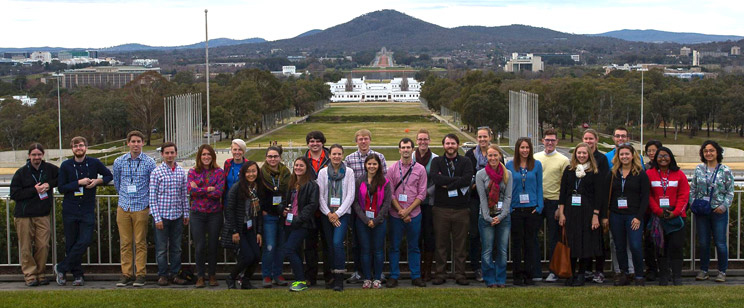
US science and engineering graduate students have visited a range of Australian scientific and cultural institutions, to conduct research and build relationships with their Australian counterparts while on their summer break.
The East Asia and Pacific Summer Institutes program (EAPSI) is organised by the Academy in collaboration with the US National Science Foundation (NSF). It is co-funded by the NSF and the Australian Government Department of Education and Training, and supported by the Australian Embassy in Washington DC and the US Embassy in Australia.
This year, the Academy welcomed 30 students for the eight-week program—the greatest number of participants in the program’s 11-year history.
Students were introduced to Australian culture and science in Canberra, with visits to the Australian War Memorial and question time at Parliament House, and learned about wildlife, bush tucker and Australia’s Indigenous history at Tidbinbilla Nature Reserve. Professor Jenny Graves AO FAA delivered a presentation describing her research on the genetics of Australian marsupials. Ms Jamie Smith, a recent EAPSI graduate, talked about her experiences during the program and what ultimately led her to relocate from the US to Australia. These lectures were followed by dinner with the Academy’s Council.
The students also had breakfast at the Shine Dome with the US Ambassador to Australia, His Excellency Mr John Berry, who encouraged them to ‘practice their elevator pitches’ and bestowed ‘honorary ambassadorial status’ on each participant.
One participant described their time in Canberra by saying:
‘...what really stands out for me is the time that we were able to spend together as a group, and the time that we were able to spend with staff and members from the Australian Academy of Science, as well as the US Ambassador and members of his staff. The conversations that I was able to have during orientation helped me to feel like I am part of the research community in Australia rather than just a visitor.’
Following the orientation program the students travelled to cities around Australia to undertake research projects under the supervision of their hosts. Host institutions included a number of universities and the Australian Institute of Marine Sciences. Areas of focus were nanostructures, soil sciences, genomics and black holes.
Applications are now open to US students who wish to join the 2016 program—more information is available on the NSF website. Applications close 12 November 2015.
© 2025 Australian Academy of Science